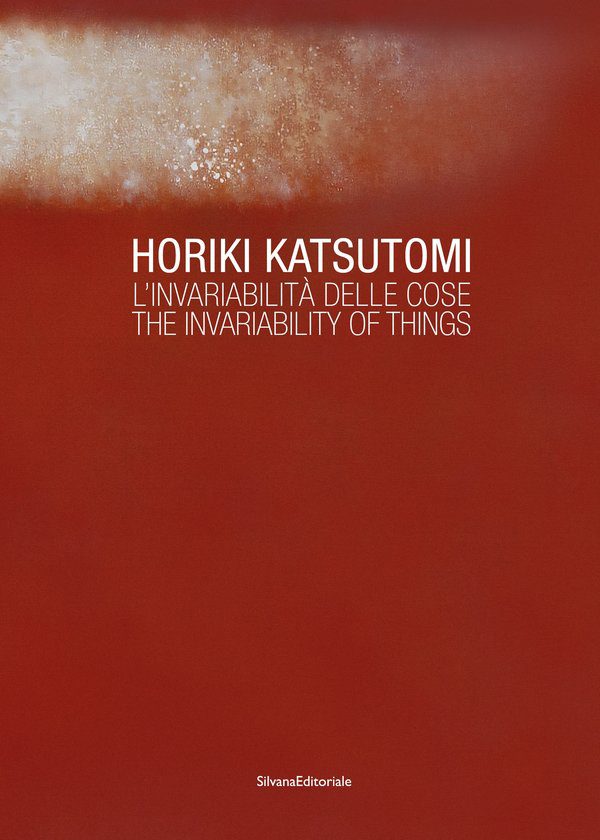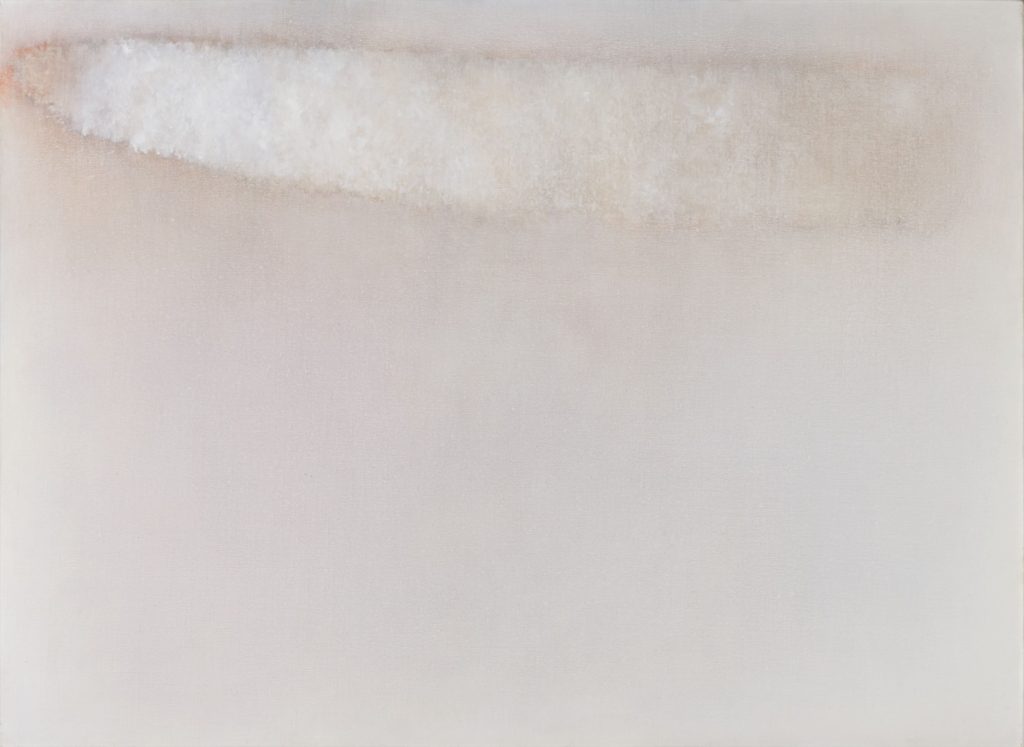Artistic journey
During this journey I have had many wonderful encounters and exchanges; naturally, these have been great lessons and moments of encouragement for me.
Many of these friends are now far distant, but the encounters increase, there are still many friends old and new with whom I express myself, perhaps using another language.
“
"
Samsara
I know that Horiki Katsutomi was already painting in Japan, but nothing I can say about that period, something instead of half a century in Italy.
I met him shortly after his arrival in Italy, in 1969. I soon wrote something about his paintings in a exhibition at the Promotrice di Belle Arti in Turin,a centuries-old institution that in the 1960s and 70s still played a promotional and documentary role independent of the market, and a solo show in Sicily. Horiki’s first exhibitions in Italy were joint enterprises with a group of friends, known in Accademia circles, a group which notably included Mimmo Gusmano, painter and organiser, who maintained close ties to his homeland of Sicily where he was highly regarded. They were all young artists outside the so-called “Arte Povera” movement, which at that time represented the Turin avant-garde. This was a choice, not an unwitting move, not least because Zorio and Penone, the movement’s protagonists, had been fellows of the Accademia Albertina. The names which recur alongside Horiki’s in various exhibitions until the mid-1970s – in Turin, Messina, Venice, and even northern Europe – are the aforementioned Gusmano, Antonio Freiles, Gianni del Bue and Pino Mantovani. They were united in their desire to remain faithful to the language of painting, to painted painting, expanded if at all through innovations gleaned from international research, ranging from Informal to Minimalism, the Analytical, geplante malerei and peinture-peinture.Horiki was not the only Japanese painter to arrive in Turin around this time: several Japanese artists took courses at the Accademia Albertina in the 1960s, particularly Sculpture, bringing materials and techniques that left traces on “Arte Povera”.
Other young Japanese students, interested in design and particularly automobile design, attended Bertone, Pinin Farina etc. On the artistic side, I think activity began at the turn of the 60s thanks to Michel Tapié – famous French critic, theorist of the Informel and Art Autre, and accomplished organizer of era-defining events and exhibitions across Europe, America and Asia – who made Turin an important centre for artistic gathering and productivity. It was probably word of that hub of exchange that induced young Japanese artists, eager to be up-to-date with “western” modernity, to move to a city which until then was quite “apart”. The city seemed destined for great things: a place where artists who exhibited in the Osaka Biennials and Tokyo like sculptors Cherchi and Garelli worked and taught; home to the Gutai group, who exhibited widely in leading galleries inspiring appreciation from collectors; and the Museum of Modern Art, endowed with a new location and open to international exhibitors.
Horiki non c’entrava con questo fenomeno “ingenuo” di migrazione. Diversa l’età; differenti l’esperienza esistenziale, la cultura, le aspettative. Horiki viene in Italia avendo già messo a punto una compiuta formazione, e avendo vissuto – in una famiglia d’alto rango, quindi specialmente esposta – la crisi che investe il Giappone nel dopoguerra. Che non è soltanto economica, etica e sociale, conseguente al disastro bellico, ma una crisi d’identità avviata da tempo, generata dal contatto inevitabile con il mondo fuori, e dal rapporto problematico con altre culture, tanto allettante quanto difficoltosamente coniugabile con una secolare separatezza. Ma è anche vero che l’Occidente, tanto l’Europa prima quanto l’America poi, subiscono il fascino delle culture orientali e in particolare della variante Giappone. Il citato Michel Tapié favorisce lo scambio di artisti e idee tra Oriente e Occidente, Occidente e Oriente, proprio contando sulla reciproca curiosità e sui vantaggi che ne conseguono, non senza fraintendimenti. Horiki è consapevole che la crisi non è locale ma universale, e non solo negativa. Forse, se non ho male inteso suoi discorsi di allora (la scarsa conoscenza della lingua non gli ha mai impedito di comunicare pensieri complessi, semmai costringendo gli interlocutori a un difficile impegno interpretativo), Horiki viene in Italia e vi si stabilisce, dopo un curioso girovagare che avrebbe potuto depositarlo altrove, per assimilare la miracolosa “certezza”, la misura della tradizione italiana, da Piero della Francesca a Morandi, da Giotto a Sironi e Burri; ma non per fuggire dalla sua tradizione, anzi. In un certo senso, per averne una visione oggettiva dalla distanza necessaria e, se possibile, capire le ragioni strutturali della crisi, e così risalire alla sua natura necessaria, fondamentalmente umana. Quella che le storie particolari hanno sparpagliato e diffuso nel vento delle approssimazioni e nella illusione di identità (e salvezze) separate, esclusive. Se i modelli formali per una soluzione erano da riconoscere nel mirabile Rinascimento classico, e forse da rintracciare in un presente selezionato in mezzo a tante deviazioni e divaricazioni; i contenuti riportavano alle origini: all’uomo stanziale che scopre i problemi del comunicare (il mito della Torre di Babele), all’uomo matematico che dalla misura particolare tenta l’universale (il mito del Centro), all’uomo votato all’abbandono ma anche al ritorno (il mito di Odisseo), all’uomo esploratore dannato alla perdita di sé, a meno che essa non consista nella identificazione con il tutto. Allora, immergersi nelle profondità della cultura occidentale diventa un modo per ritrovare intera la profondità della cultura orientale.
But Horiki was also an art professionist, in the most rigorous and methodical sense of the term. And on this level it is worth following him. Since 1976/77, after a period of adjustment, as said at the beginning, Horiki’s relationship with the art world (from the point of view of operation and distribution) changed radically. Three new galleries, destined to become prominent in Turin, systematically welcomed his work and documented his development in solo and group exhibitions: Mantra Gallery (then Tonin), Marin Gallery (then Salzano), Weber Gallery (then Weber and Weber). The same galleries organized in the following decades Horiki’s presence in international fairs, in Bologna, in Bilbao in Madrid etc. In 1977 he was invited for the first time to the X Quadriennale in Rome and began to attend Art Schows (in particular he was assiduous to the Sulmona Prize, of which he won in 2007 the First Prize) and later National and International Art Symposia. Rare and meditate were the solo exhibitions.
In the mid-90s Horiki moved from Turin to Cigliano, a small town in the Vercelli countryside, where he set up a spacious studio in order to create large-scale works (not that he had not produced these when space was limited) and to check in situ the coherence of variations on a theme. His method, from the start, consisted of working in cycles. At the end of each cycle he found a way to arrange a personal record of the completed work in galleries or specially adapted locations pertinent to the cycle, chosen for their characteristics or symbolic value: as in 1994 at Palazzo Pretorio di San Sepolcro, the birthplace of Piero della Francesca chosen for the exhibition dedicated to the True Cross cycle; or, widening the field, in 2009 in Delft in the Netherlands, hometown of Vermeer, chosen for a retrospective exhibition at World Art Delft. Finally, he featured in select groups and small exhibitions in exquisite settings provided by friends: in Alexandria (Triangolo Nero, thanks to painter/engraver and friend Gianni Baretta , 1999, 2004, 2011), Treville (Church of San Giacomo, 2005, thanks to painter and friend Mario Surbone), and Turin (Mutabilis Gallery, a place dedicated to the legacy of friend and artist Sergio Agosti).
Horiki paid particular attention to texts on catalogues. With a constant: almost always the critics involved were people with whom he had established or would establish a friendly contact, perhaps better a dialectical relationship. Each meeting was an opportunity to deepen the awareness of their commitment, using the intelligence and culture of the new interpreter. In the initial season, the interlocutors were friends (Mimmo Gusmano, Pino Mantovani, Giancarlo Salzano, Riccardo Cavallo).
In the second season, relations widened by ramifications: through the gallerist/intellectual Giancarlo Salzano (also one of his first exegetes) Horiki knew Francesco Bartoli and Gino Baratta, fine interpreters, on the basis of a deep knowledge of the linguistic structures, the seal and the “imprints” that characterize Horiki’s first mature season; as Andrea Balzola, Gino Gorza and Alberto Veca, who accompanied Horiki in evaluating the change represented by the "History of the True Cross", which he developped and perfected over a decade. In the third season the meeting with Elena Pontiggia was certainly fundamental: in fact Pontiggia wrote repeatedly about Horiki, bringing an essential contribution to the interpretation of the pictures from the cycle of the "True Cross". She dedicated to Horiki a first essay published in the catalogue for the exhibition of Sansepolcro, then to the cycle of the "Odyssey", in 1994, and eventually with an essay that introduces, together with a brief statement by the artist, the posthumous monograph on Horiki. But this is also the period full of contributions differentiated by perspectives and methods of investigation: which however have in common the use of poetic citation as a synthetic evocative tool, where the phenomenological, structural, iconological interpretation appears insufficient or difficult. This is not the place to comment on commentators on Horiki’s work, but at least three cases are essential.
The first finds its most complete manifestation in the essay by Aart van Zoest that introduces the exhibition of 2009 in Delft: in it, the author, using noble references, Rothko and Opalka, questions the proximity of Horiki to the terms placed by Pierce at the foundation of his semiotics, icon, index and symbol, making acute observations on the importance of communicating for the Japanese painter, through the allusive (if not descriptive) image and the word that accompanies it. (About this I must point out that Horiki has used for years acronyms composed of letters and numbers, coming to the title only in 1984/5).
La seconda, riconoscibile nei saggi di Alberto Veca, di Franca Varallo, della stessa Pontiggia, ci insegna ad osservare con particolare attenzione le infinitesime vibrazioni materiche, di luce e di colore che caratterizzano il lavoro di Horiki, a tutte le distanze e con gli strumenti disponibili, naturali e artificiali. La terza affronta il contenuto mitico che qualifica la pittura (il pensiero in pittura) di Horiki, che preserva fuori dal tempo il valore dell’invisibile come parte essenziale dell’esperienza esistenziale (Gaspare Luigi Marcone, Alessandra Ruffino, Valerie Humbert). Infine, il compositore Alberto Lo Gatto ha proposto una lettura per corrispondenza musicale, da Horiki molto apprezzata, e recentemente Danilo Karim Kaddouri ha tradotto musicalmente il senso dei primi quadri nella composizione For an absence, for two flutes and snare drum (2021).
Text by Pino Mantovani
Accademia Albertina, Turin

Horiki Katsutomi
L’invariabilità delle cose/The Invariability of Things
2022
Cinisello Balsamo
Silvana Editoriale
ISBN-13. 978-88-366-5056-2
Get in touch





